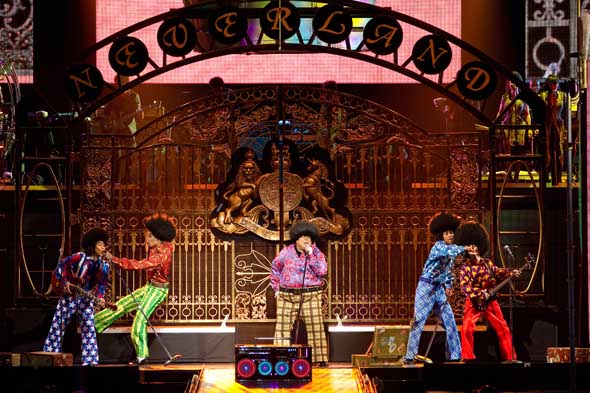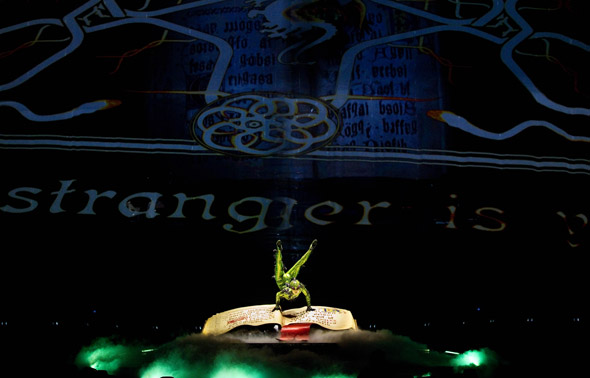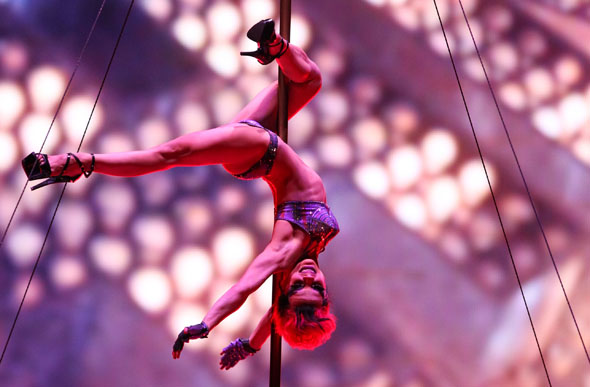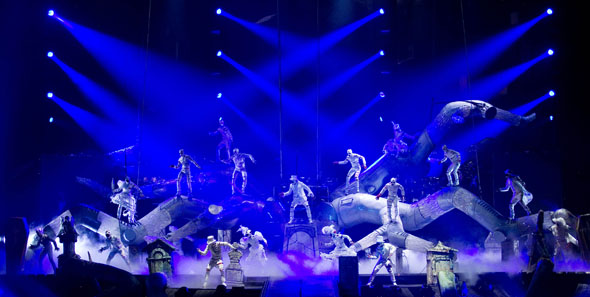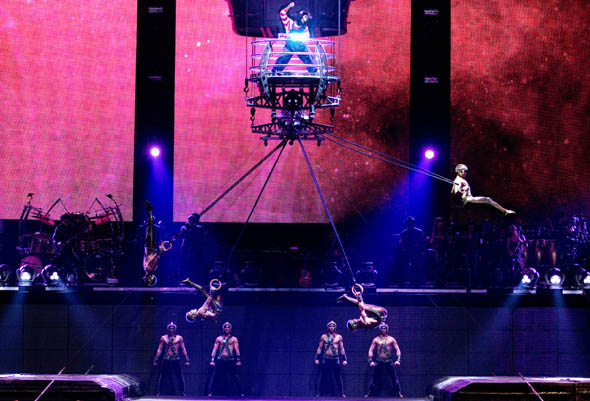Cirque du Soleil's Michael Jackson Immortal Takes Audience On A Dazzling Ride
by Joe Vogel
Cirque du Soleil's
Michael Jackson: The Immortal World Tour made its U.S. debut Saturday night at Joe Louis Arena in Detroit, Michigan. The two-hour audio-visual spectacle offered a feast for the senses as it celebrated the creative output and social ideals of the late King of Pop.
Before the show, an anxious crowd -- young, old, black, white and every demographic in between -- waited in the brisk October air, exchanging memories. A middle-aged man recalled attending the Victory Tour in 1984. A young girl remembered sobbing the day she learned of his passing and playing "Will You Be There" on repeat. An elderly woman spoke of seeing the Jackson 5 perform in Detroit in 1969. "I still can't believe he's gone," she lamented.
Coming just a couple of years after Jackson's tragic death -- and in the midst of the trial of his personal physician, Dr. Conrad Murray -- the show seemed to offer a cathartic experience for many attendees, while introducing an accessible version of him to a yet another generation of music listeners.
The show itself is a hybrid extravaganza: part rock concert, part theater, part acrobatics, part comedy, part festival. Its tone is more whimsical than Jackson's world tours. With no front man, the show opts instead for a five-person crew of slapstick dancer-impersonators called the "fanatics" and a versatile mime. Numerous other talents are featured in spots, including a mesmerizing contortionist, a fierce cellist, and a phenomenally gifted young boy.
The show uses a live band, led by Jackson's longtime collaborator Greg Phillinganes, to amplify the concert feel and introduces several signature MJ props (the glove, the hat, the penny loafers) to playfully point to the pop icon.
Still, it is difficult to overcome Jackson's absence on stage. His presence on the jumbo screen in the opening montage generates a tangible excitement -- it is as if the audience is waiting for him to pop up at any moment. During some of the quieter parts of the show -- "I'll Be There," "Gone Too Soon" -- audience members cry out, "We love you, Michael!"
To try to fill the void, director Jamie King and set designer Mark Fisher wisely chose Michael Jackson's "Giving Tree" as the anchoring scenic piece and controlling metaphor, creating a symbolic world for Jackson's memory to occupy. Unfortunately, the tree didn't make it to the Detroit show due to technical problems, causing the narrative thread to feel a bit disjointed and some of the numbers to be altered.
There were some other indications that the show was still finding its footing. The pacing at times was a bit turbulent and fragmented. Michael Jackson had an uncanny ability as a creator/performer to take his audience on a journey and not lose them for a second: he knew when to go big and when to pull it back, when to be extravagant and when to be subtle. He was a master of pathos and of building dramatic tension.
While the
Immortal show hasn't yet reached that lofty standard, it does manage to capture certain parts of his essence. The transition from the wonder-filled "Childhood," which allows the audience to see inside the Neverland Gates as bronze statues of children come to life, segues magnificently into the frenetic, tribal energy of "Wanna Be Startin' Somethin.'" The medley of
Heartbreak Hotel/Smooth Criminal/In the Closet/Dangerous also works well, blending film noir and music video footage with a cello solo, seamless choreography and a pole dancer. Likewise, the medley of
Ghosts/Is It Scary/Threatened/Thriller, which begins with a creature crawling out of a large storybook, is one of the show's highlights.
Notably absent from the lineup is "The Way You Make Me Feel," a classic which Jackson performed at every concert since the
Bad World Tour. There are some nice, lesser-known surprises, however, including parts of "In the Closet," "Speechless" and "Little Susie." Nearly all of the songs, including "Billie Jean," are formed in clusters with two or three other tracks.
Dazzling touches abound. Around the mid-way point, there is a beautiful sequence in which Jackson describes how he is "just the medium through which the music flows." This quote is interpreted by the mime as he allows the sound to work through his body while musical notes float into the air. It is followed by a gorgeous rendition of "Human Nature."
While the show primarily presents Jackson as man-child/idealist, occasionally other facets break through. For "They Don't Care About Us," taking its cues from concert plans for
This Is It, an army of robots march in unison, flashing money signs and question marks as a video montage plays footage of violence, despair and destruction.
The finale returns to safer ground, offering a healing call for peace, unity and love to a mash-up of socially conscious anthems like "Can You Feel It," "Black or White" and "Man in the Mirror." Flags are brought on stage in a festival-like fusion of cultures, acrobatics, dance and music.
For all the elaborate staging and impressive talent, however, the unquestionable star is Michael Jackson. Musical designer Keven Antunes was given access to the artist's original multi-track master recordings and stripped away some of the production to put Jackson's singular voice on full display. On some of the ballads especially -- "I'll Be There," "I Just Can't Stop Loving You" -- the effect is stunning. His appearances on the jumbo screens likewise brought a visceral energy to the show.
Afterward, outside the arena kids excitedly described their favorite parts of the show. One of them, eyes wide, talked about the LED costumes that lit up during "Billie Jean." In the distance, by the parking garage, a man played "Thriller" on his saxophone, its strains rising plaintively into the night. He couldn't afford tickets to the show, he said, but he wanted to be nearby to "celebrate the king."
http://www.huffingtonpost.com/joe-vogel/cirque-du-soleils-michael_b_1016774.html

